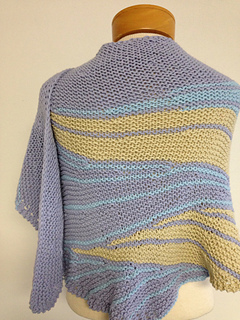patterns >  Short Stripes Trio and 2 more...
Short Stripes Trio and 2 more...
> Robin



























Robin
This pattern is for any weight yarn! Work at any gauge (no swatch necessary) to make any size shawl you want.
Made up of repeating sections, each section made up of repeating wedges, this shawl can be worked up as big as you want it, in any weight yarn, and the shape can vary from nearly symmetrical to very asymmetrical depending on when exactly you decide to stop knitting.
Work simple short rows with stripes in garter stitch, carrying both your yarns along as you go with some tricks which will prevent the need to weave in dozens of ends (you’ll only break your yarn a couple times).
Make a shawl in 2 or 3 colors, and work until one of your yarns runs out, binding off at any point within a section to get the most shawl out of your yarns. Or choose to finish when it reaches your ideal size and/or shape - the choice is yours!
Detailed photo tutorials are included for the yarn carrying techniques, and instructions are included for working short rows, the stretchy bind-off, and how to use your colors and get your ideal shape, etc, plus modification options explained.
The samples shown are in DK weight and worsted weight, but you can use any weight to make this shawl, from lace to bulky!
The 9 page pattern includes several process photos, detailed technique tutorials, and modification notes, so you can make your perfect custom shawl.
This shawl is part of the leethal Short Stripes Trio - 3 different accessory patterns which each feature short rows and stripes! Maurice the cowl, Barry the hat, and Robin the shawl (this pattern) all play with stripes and short rows in different ways, and are all fun and unique designs with lots of variations. (Each single pattern is $6; the whole trio is $12.)
You need
- your choice of yarn in any weight, in 2 or 3 colors - estimates are vague because sizes can vary greatly (see gauge, sizing, and colors notes)
- -- bulky: 200-500 yards / 180-450 meters total
- -- worsted: 300-600 yards / 275-550 meters total
- -- sport: 400-900 yards / 350-800 meters total
- -- fingering: 500-1200 yards / 450-1100 meters total
- needles sized to match yarn
- -- a long circular (32 inches / 80 cm or longer)
- 2 stitch markers (different colors/types)
The samples:
- Green and brown (2 color version): Stonehedge Fiber Mill Shepherd’s Wool worsted (MC is Lime Green, CC is Milk Chocolate) - 457 yards / 418 meters total (244yds/223m MC, 213yds/195m CC).
- Blue/pink/green (3 color version): Sandnes Garn Alpakka (MC is blue #6554, CC2 is pink #4611) and Brown Sheep Lanaloft sport weight (Celery) - 550 yards / 503 meters total (357yds/326m MC, 68yds/62m CC1, 125yds/114m CC2).
Gauge
This pattern is for any gauge, any weight yarn. Use needles sized to work well with your yarn; no need to make a gauge swatch before starting. To get a nice drapey fabric, you may want to use a needle size larger than the standard, by one or two sizes.
Obviously you’ll get different kinds of shawls with different weights - a squishy, chunky shawl in bulky, versus a more delicate, lighter weight piece in sock weight, etc - so choose your weight according to your preferences. You can make any size in any gauge.
Sizing/shape
You’ll repeat the shawl parts for as many sections as you want, until you reach your desired size, which could be anywhere from just a few sections to all 10 sections (although you’ll most likely stop after/during around 4-6 sections). The piece is worked from the bottom point, up and out, so you can stop anywhere and get some kind of rounded triangle shape.
Your shawl shape is determined by exactly when you stop knitting and bind off; if you stop after completing an entire section (any section, either left or right), you’ll have an asymmetrical shape. In order to get a more symmetrical triangle, you need to stop and bind off after a couple of wedge repeats into any section.
The shawl is designed to make it easy to use up your yarn and not have to worry about running out. If you have two or more skeins that are enough to make a shawl, like two skeins of sock yarn perhaps (this depends on weight/size preference/per-skein yardage), then you can just keep working until your yarn is just about used up (specific notes are included in the pattern) and bind off at any point when you’re out of yarn, no need to finish a wedge/section.

9298 projects
stashed
5797 times
24166 projects
stashed
15682 times
- First published: March 2013
- Page created: March 21, 2013
- Last updated: November 6, 2024 …
- visits in the last 24 hours
- visitors right now






